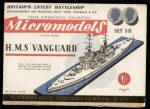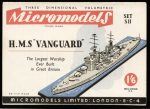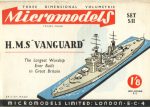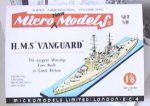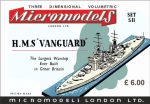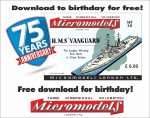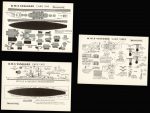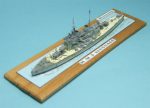S II HMS Vanguard
| Number | S II |
| Name | H.M.S “Vanguard” |
| First year published | 1949 |
| Publisher | Micromodels |
| Number of cards | 1/-d edition: 3 1/6d and 1/8d edition: 3 plus base card |
| Size of cards | 9 x 13 cm |
| Scale | 1 : 2300 |
| Description | First issued in late 1949 at 1/-d. Out of print during 1951 and 1952. Reprinted in 1953 at 1/6d. There is also a version with a 1/8d price sticker over the 1/6 price. This is done by Broadway Approvals in 1958. Stocks of the 1/6 reprint were passed down the line to the Watford Model Supply Co. in 1971. The differences between the two printings are worth noting:
Set S II Vanguard is the smallest issued Micromodel. Autocraft and Micromodels London have also published the Vanguard. |
| Graham Dixey had the following to say about his model of HMS Vanguard:“The HMS Vanguard is very largely scratchbuilt, certainly in terms of the upperworks, using mostly just the original hull and basic superstructure. The model is awful! Really inaccurate and lacking details. When I decided to build my model I took photos of the original dockyard model, which is in the Science Museum, London, so I can vouch for its accuracy. I have added an enormous amount of detail, mostly from scrap card, wood and stretched plastic sprue.” | |

